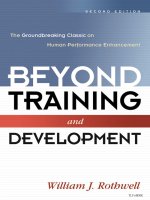Employee training and development 5th chapter 03
Bạn đang xem bản rút gọn của tài liệu. Xem và tải ngay bản đầy đủ của tài liệu tại đây (684.18 KB, 34 trang )
Chapter 3
Needs Assessment
McGraw-Hill/Irwin
Copyright © 2010 by the McGraw-Hill Companies, Inc. All rights reserved.
Why is Needs Assessment
Necessary?
Training may be incorrectly used as a
solution to a performance problem.
Training programs may have the wrong
content, objectives, or methods.
Trainees may be sent to training
programs for which they do not have the
basic skills, prerequisite skills, or
confidence needed to learn.
3-2
Why is Needs Assessment
Necessary? (cont.)
Training will not deliver the expected
learning, behavior change, or financial
results that the company expects.
Money will be spent on training programs
that are unnecessary because they are
unrelated to the company’s business
strategy.
3-3
Figure 3.1 – Causes and Outcomes
of Needs Assessment
3-4
Table 3.1 – Key Concerns of Upper-Level and
Mid-Level Managers and Trainers in Needs
Assessment
3-5
Who Should Participate in Needs
Assessment (cont.)
It is important to get a sample of job
incumbents involved in the needs
assessment because:
they tend to be most knowledgeable about
the job.
they can be a great hindrance to the training
process if they do not feel they have had
input in the process.
Job incumbents – employees who are
currently performing the job.
3-6
Table 3.2 – Advantages and Disadvantages
of Needs Assessment Techniques
3-7
Table 3.2 – Advantages and Disadvantages
of Needs Assessment Techniques
3-8
Methods Used in Needs
Assessment
Because no one technique of conducting
needs assessment is superior to the
others, multiple methods are used.
Many companies are following
benchmarking – using information
about other companies’ training practices
to help determine the appropriate type,
level, and frequency of training.
3-9
Figure 3.2 - The Needs
Assessment Process
3-10
Table 3.3 - Questions to Ask in an
Organizational Analysis
3-11
Table 3.4 – Questions to Ask
Vendors and Consultants
3-12
The Needs Assessment Process
(cont.)
Person analysis involves:
determining whether performance
deficiencies result from a lack of knowledge,
skill, or ability (a training issue) or from a
motivational or work-design problem.
identifying who needs training.
determining employees’ readiness for
training.
3-13
The Needs Assessment Process
(cont.)
Readiness for training – refers to
whether:
employees have the personal characteristics
necessary to learn program content and apply
it on the job.
the work environment will facilitate learning
and not interfere with performance.
This process includes evaluating person
characteristics, input, output,
consequences, and feedback.
3-14
The Needs Assessment Process
(cont.)
A major pressure point for training is
substandard or poor performance.
Another potential indicator of the need for
training is if the job changes such that
current levels of performance need to be
improved or employees must be able to
complete new tasks.
3-15
Figure 3.3 – Process for Analyzing the Factors That
Influence Employee Performance and Learning
3-16
The Needs Assessment Process
(cont.)
Cognitive ability includes three
dimensions: verbal comprehension,
quantitative ability, and reasoning ability.
Readability refers to the difficulty level
of written materials; readability
assessment usually involves analysis of
sentence length and word difficulty.
3-17
The Needs Assessment Process
(cont.)
Employees’ self-efficacy level can be
increased by:
Letting employees know the purpose of
training.
Providing as much information as possible
about the training program and the purpose of
training prior to the actual training.
3-18
The Needs Assessment Process
(cont.)
Employees’ self-efficacy level can be
increased by:
Showing employees the training success of
their peers who are now in similar jobs.
Providing employees with feedback that
learning is under their control and they have
the ability and the responsibility to overcome
any learning difficulties they experience in the
program.
3-19
The Needs Assessment Process
(cont.)
To ensure that the work environment
enhances trainees’ motivation to learn:
Provide materials, time, job-related
information, and other work aids necessary
for employees to use new skills or behavior
before participating in training programs.
Speak positively about the company’s training
programs to employees.
3-20
The Needs Assessment Process
(cont.)
To ensure that the work environment
enhances trainees’ motivation to learn:
Encourage work-group members to involve
each other in trying to use new skills on the
job.
Provide employees with time and
opportunities to practice and apply new skills
or behaviors to their work.
3-21
The Needs Assessment Process
(cont.)
To determine whether training is needed to
solve a performance problem, managers
should assess the following:
Is the performance problem important? Does it
have the potential to cost the company a
significant amount of money from lost
productivity or customers?
Do the employees know how to perform
effectively?
Can the employees demonstrate the correct
knowledge or behavior?
3-22
The Needs Assessment Process
(cont.)
To determine whether training is needed
to solve a performance problem,
managers should assess the following:
Were performance expectations clear (input)?
Were there any obstacles to performance such
as faulty tools or equipment?
Were positive consequences offered for good
performance? Was good performance not
rewarded?
3-23
The Needs Assessment Process
(cont.)
To determine whether training is needed
to solve a performance problem,
managers should assess the following:
Did employees receive timely, relevant,
accurate, constructive, and specific feedback
about their performance?
Were other solutions such as job redesign or
transferring employees to other jobs too
expensive or unrealistic?
3-24
The Needs Assessment Process
(cont.)
Task analysis – identifies the important
tasks and knowledge, skills, and
behaviors that need to be emphasized in
training for employees to complete their
tasks.
Job – specific position requiring the
completion of certain tasks.
Task – employee’s work activity in a
specific job.
3-25









